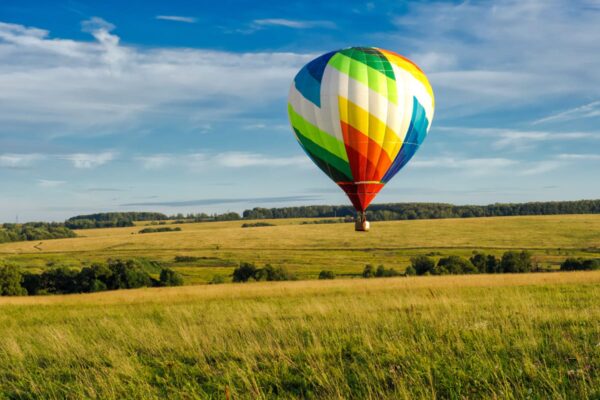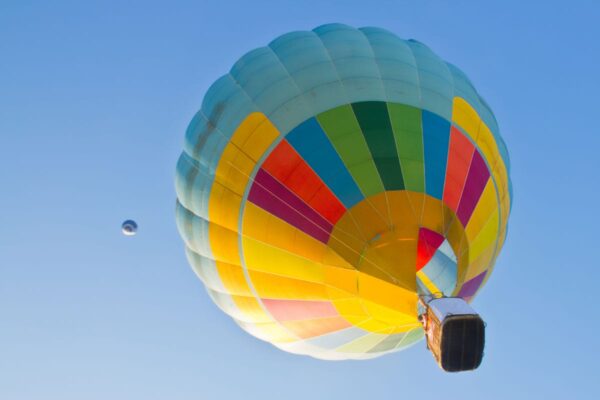Balloon flights have fascinated people for centuries. Hovering high above the ground, admiring landscapes from a bird’s perspective and experiencing extraordinary silence interrupted only by the hum of the burner – all this adds up to an unforgettable experience. However, the safety of such an adventure depends mainly on weather conditions. Hot air balloons are extremely sensitive to weather changes. Balloon pilots must carefully analyze forecasts and observe current conditions before each launch.
Balloon flight requires stable, mild winds, good visibility and no precipitation. Even when skies appear clear, a flight may be canceled due to unfavorable forecasts for the coming hours. The pilot must be sure that the weather will remain favorable throughout the flight, which can last one to two hours.
The safety of passengers and crew always comes first. Therefore, the decision to fly or cancel a flight is based on a detailed analysis of many weather factors. Wind, precipitation, temperature, visibility – all are critical to a safe and enjoyable balloon flight experience.
Understanding how different weather conditions affect balloon flights allows you to better prepare for such an adventure and understand why flights sometimes have to be postponed or canceled. Learning about these relationships helps you appreciate the complexity and beauty of ballooning as a sport and pastime.
The impact of wind on balloon flight safety
Wind is the most important weather factor affecting balloon flights. Its strength and direction determine not only the possibility of takeoff, but also the flight route and landing site. Balloons fly best in stable, light winds of 4 to 6 miles per hour (about 6-10 km/h).
Maximum safe wind speed
Balloons can fly in winds up to 8-10 miles per hour (13-16 km/h), but stronger gusts pose a danger. When filling the balloon with cold air using a fan, the balloon material acts as a huge sail. Winds approaching 10 miles per hour can prevent the balloon from inflating, collapsing its sides and causing uncontrolled movements sometimes even violent ones.
Strong winds can also carry the balloon too far or into areas unsuitable for landing, such as urban areas, forests, restricted areas or bodies of water. The inability to steer the balloon in a direction other than where the wind is blowing makes wind speed critical to safety.
Winds at different altitudes
Even when the ground is completely quiet, a flight can be canceled due to strong winds at higher altitudes. Pilots check not only the wind near the ground, but also at altitudes from 300 to 2,700 meters.
Types of winds affecting balloon flight:
- Ground winds (those that can be felt)
- Winds at an altitude of 300-900 meters
- Winds at an altitude of 900-1800 meters
- Winds at an altitude of 1800-2700 meters
Although balloons do not ascend to 2,700 meters, information about winds at this altitude helps pilots anticipate potential problems such as wind upsets, turbulence or strong surface winds later on. Winds at an altitude of 18-20 knots (about 33-37 km/h) can be sufficient reason to cancel a flight.
Testing the wind before the flight
Pilots often use a small helium-filled balloon (known as a pi-ball) to visually assess the wind. If such a balloon reaches treetop height and then rapidly flies away, this indicates a wind dodge, which can be dangerous for the balloon to take off. It is equally dangerous to land a balloon in high winds.
Tip: When booking a balloon flight, it’s a good idea to ask about the company’s policy on cancellations due to weather conditions and the possibility of rebooking for another date.
Balloon flights during rain and snowfall
Rain and snow pose a serious threat to the safety of balloon flights. Unlike airplanes, balloons cannot fly away from rain or thunderstorms, which makes flying in such conditions particularly risky.
Why rain is dangerous for balloons
Hot air balloons need to maintain the right temperature inside the shell to stay in the air. Rain cools the balloon’s shell, making it more difficult to control the balloon. The top of the balloon reaches a temperature of about 100 degrees Celsius (the boiling point of water), and when it rains, the water cools the shell.
The pilot then has to use the burner more often to compensate for the loss of heat, otherwise the balloon will drop quickly. However, excessive use of the burner can cause overheating at the base of the balloon, which can damage the shell material.
Additional problems associated with rain
Rainfall increases the weight of the balloon, requiring more heat to keep it in the air. Water runs down the sides of the balloon’s shell and drips into the basket, soaking passengers and equipment. Even light rain can pose a danger if proper safety measures are not taken.
Consequences of flying in the rain:
- Cooling of the balloon shell
- Increasing the weight of the balloon
- The need to use the burner more often
- Risk of running out of propane supplies
- Discomfort of passengers
- Difficulty in controlling the balloon
Snow and its impact on balloon flights
Snow poses similar problems to rain, but in addition it can weigh down the balloon and reduce visibility. Pilots must approach such situations with caution, adjusting altitude or deciding to land if necessary. Navigating in snow requires skill, experience and adaptability from both pilot and crew.
Professional approach to precipitation
Reputable ballooning companies always put safety first and do not undertake flights in the rain or when precipitation is forecast. Even if the rain is light, professional pilots know that the risk is not worth taking.
Tip: When planning a balloon flight, it’s best to book it at the beginning of your stay in a particular location so that you have the option of postponing the flight to another day in case of bad weather.
Professional balloon flights with ProBallooning
ProBallooning is a company specializing in organizing unforgettable balloon flights, combining a passion for ballooning with the highest safety standards. Founded by experienced pilots, the company offers a variety of customized services.
ProBallooning Company
ProBallooning operates in the market of ballooning services, providing an unforgettable experience for those passionate about sky adventures. The company employs qualified pilots with years of experience, who have undergone rigorous training and have all the necessary certificates. Safety is an absolute priority, so each flight is preceded by a thorough analysis of weather conditions.
The company’s fleet consists of modern balloons of various sizes, regularly serviced and maintained in perfect technical condition. Each balloon is equipped with state-of-the-art safety and communication systems.
Balloon flight offer
ProBallooning offers a wide range of services to suit different needs and occasions. Customers can choose from a variety of flight options, from standard to exclusive.
Types of flights available at ProBallooning:
- Standard flights for groups
- Private flights for couples
- Engagement flights
- Wedding flights
- Corporate and team-building flights
- Special occasion flights (birthdays, anniversaries)
- Photo flights
Each flight includes transportation from the assembly point to the launch site, a safety briefing, the flight itself lasting about an hour (depending on weather conditions), a toast after landing and a flight certificate. In addition, the company offers the opportunity to purchase professional photos and videos of the flight.
Customer reviews
ProBallooning’s customers speak highly of the company’s professionalism and approach to safety, and praise the pilots’ experience, flight organization and unforgettable experience.
Many customers emphasize that despite their initial apprehension about the balloon flight, the professional approach of the ProBallooning crew made them feel safe throughout the adventure. Particularly appreciated are the detailed information provided before the flight and the flexible approach to rescheduling in case of unfavorable weather conditions.
Tip: When booking a flight with ProBallooning, it is a good idea to inform about special occasions (birthdays, anniversaries, engagements) so that the company can prepare a suitable setting for the event.
Optimal weather conditions for a successful balloon flight
The ideal conditions for a balloon flight are a combination of several key atmospheric factors that ensure both safety and comfort. Knowing these conditions helps you understand why some days are better for ballooning than others.
Ideal air temperature
Contrary to popular belief, hot air balloons prefer cooler conditions. When the atmospheric temperature is cooler, it is easier and faster to create a temperature difference between the air inside the shell and the air surrounding the balloon.
In cold weather, it is easier for the balloon to gain buoyancy. The principle of the balloon is based on the fact that the air inside must be warmer than the air outside to keep the balloon in the air. On warm days, it takes more fuel and more heat to warm the air inside the balloon.
The shell material has a maximum temperature allowed by the manufacturer, which the pilot should not exceed. That’s why balloon flights often take place in the early morning or late evening, when the air temperature is cooler.
Optimum wind conditions
The best wind conditions for balloon flights are stable and light winds of 4 to 6 miles per hour (6-10 km/h). Maximum safe winds are 8-10 miles per hour (13-16 km/h).
Wind affects every phase of the flight – from filling the balloon, to the flight itself, to landing. Too much wind can make filling the balloon nearly impossible and landing dangerous. A lack of wind, on the other hand, means that the balloon will not cover a significant distance.
Weather factors favorable for balloon flights:
- Air temperature: cooler (preferably early morning or late evening)
- Wind: stable, 4-6 miles per hour
- Visibility: good (1-3 miles minimum)
- Overcast: no low convective clouds
- Precipitation: none
- Atmospheric fronts: none in the area
Importance of good visibility
Balloon pilots operate under visual flight rules (VFR). This means that they must have a certain amount of visibility in order to fly. Depending on the location of the flight, visibility must be at least 1 to 3 miles (1.6-4.8 km). For this reason, flights do not take place at night or in fog.
Good visibility is crucial for both safety and flight enjoyment. Passengers want to enjoy the view, and the pilot must be able to clearly see potential landing sites.
Tip: The best time for a balloon flight is usually early morning, just after sunrise, when the air is cooler and calmer and visibility is best.
When a balloon flight must be canceled
The decision to cancel a balloon flight is never taken lightly. Professional pilots and balloon companies put safety above all else, so there are strict conditions under which flights must be canceled.
Exceeding safe wind limits
The most common reason for cancelling flights is too much wind. Balloons can only fly safely in winds up to about 8 knots (15 km/h). In stronger winds it becomes difficult or impossible to fill the balloon.
The balloon has a huge surface area – it can reach up to 40 meters high standing on the ground. It needs very calm and stable conditions for the first few hundred feet so that it can be safely inflated and launched. Once up, the balloon can fly a little faster, but within reason. Calm conditions are also needed during landing.
Therefore, the ground wind for the first few hundred feet is crucial, not just the wind speed at ground level.
Flight cancellation scenarios
There are three main scenarios in which a balloon flight can be canceled due to weather:
Three types of balloon flight cancellations:
- Cancellation the day before the flight (when forecasts are unambiguously unfavorable)
- Cancellation on the day of the flight (when conditions have changed since the previous evening)
- Cancellation at the launch site (when actual conditions do not match forecasts)
The last scenario is the least desirable, since passengers are already at the launch site, but is sometimes necessary to ensure safety. Professional balloon companies do everything possible to notify passengers of a cancellation as far in advance as possible.
Other conditions forcing cancellation
In addition to wind, there are several other weather conditions that can cause flight cancellations:
- Very hot mornings (affecting balloon performance)
- Rain or a forecast of rain
- Complete ban on the use of fire
- Low visibility (fog/extremely low cloud)
- Thunderstorms
- Atmospheric fronts in the area (usually bring a change in wind direction or increased wind speed)
Thunderstorms are particularly dangerous – professional pilots do not take off if there are thunderstorms within 100 miles (160 km) of the launch site. Lightning striking a balloon is an extremely dangerous hazard.
Tip: When booking a balloon flight, always make sure the company has a clear refund or rebooking policy in case the flight is canceled due to weather.
How high temperatures affect balloon flights
Hot weather and balloon flights do not go hand in hand. High temperatures not only cause discomfort for passengers, but also create significant challenges for the pilot and the balloon itself.
Effects of high temperatures on balloon performance
Hot air is less dense, which means the balloon needs more heat to generate enough lift. This can make the balloon appear heavy and more difficult to control. On hot days, the pilot has to use the burner more often and more intensively, which increases fuel consumption.
The balloon’s shell material has a certain maximum temperature it can withstand. On hot days, the difference between the air temperature outside and the temperature needed inside the balloon is smaller, which limits the safety margin.
Temperature at different altitudes
It is commonly believed that the temperature decreases by about 3°F (about 1.7°C) for every 1,000 feet (305 meters) of altitude. However, this rule of thumb does not always hold true in hot weather. In addition, the balloon’s powerful 20-30 million BTU burners add even more heat, raising the temperature in the basket by 10-15°F (5.5-8.3°C).
This means that even at higher altitudes on hot days it can be very warm, affecting passenger comfort and balloon performance.
Unpredictable wind patterns
High temperatures can create thermals, gusts and irregular wind patterns as hot pockets of air rise and mix with cooler air masses. These unpredictable conditions can make it difficult for the pilot to control the balloon and plan the flight path.
Problems associated with flying in high temperatures:
- Reduced balloon performance
- Increased fuel consumption
- Unpredictable wind patterns
- Discomfort for passengers
- Limited temperature safety margin
When the temperature is too high, the safest choice is to cancel the flight. Professional pilots always put passenger safety and comfort above everything else, ensuring that every flight is both safe and enjoyable.
Tip: If you are planning a balloon flight in a warm climate, choose a date in the early morning, when temperatures are lowest and conditions are most stable.
Summary
Balloon flights are an extraordinary experience, but their safety depends on many weather factors. Wind remains the most important element affecting the feasibility of the flight – balloons perform best in stable, light winds of 4-6 miles per hour. Exceeding 8-10 miles per hour usually means the flight must be canceled.
Rain and snow rule out the possibility of safe flight, as they cool the balloon’s envelope, increase its weight and make it more difficult to control. Temperature also plays a key role – contrary to intuition, balloons perform better in cooler air, as it is then easier to achieve the right temperature difference between the inside of the balloon and the environment.
Professional ballooning companies, such as ProBallooning, always put safety first. The decision to cancel a flight is never made hastily and is always based on concern for passengers and crew. There are three main cancellation scenarios: the day before the flight, on the day of the flight or at the launch site.
Optimal conditions for a balloon flight include cooler air (preferably early morning or late evening), stable and light winds, good visibility and the absence of precipitation and weather fronts. Meeting these conditions ensures not only safety, but also maximum enjoyment of the flight.
Understanding how different weather conditions affect balloon flights allows you to better prepare for such an adventure and appreciate the professionalism of pilots who make difficult safety decisions. Balloon flight is not just a tourist attraction, but the art of balancing the natural forces of nature with human technology and skill.





